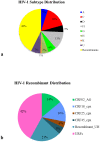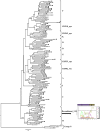HIV-1 genetic diversity and transmitted drug resistance mutations among patients from the North, Central and South regions of Angola
- PMID: 22952625
- PMCID: PMC3430682
- DOI: 10.1371/journal.pone.0042996
HIV-1 genetic diversity and transmitted drug resistance mutations among patients from the North, Central and South regions of Angola
Abstract
Background: Angola presents a very complex HIV-1 epidemic characterized by the co-circulation of several HIV-1 group M subtypes, intersubtype recombinants and unclassified (U) variants. The viral diversity outside the major metropolitan regions (Luanda and Cabinda) and the prevalence of transmitted drug resistance mutations (DRM) since the introduction of HAART in 2004, however, has been barely studied.
Methods: One hundred and one individuals from the Central (n = 44), North (n = 35), and South (n = 22) regions of Angola were diagnosed as HIV-1 positive and had their blood collected between 2008 and 2010, at one of the National Referral Centers for HIV diagnosis, the Kifangondo Medical Center, located in the border between the Luanda and Bengo provinces. Angolan samples were genotyped based on phylogenetic and bootscanning analyses of the pol (PR/RT) gene and their drug resistance profile was analyzed.
Results: Among the 101 samples analyzed, 51% clustered within a pure group M subtype, 42% were classified as intersubtype recombinants, and 7% were denoted as U. We observed an important variation in the prevalence of different HIV-1 genetic variants among country regions, with high frequency of subtype F1 in the North (20%), intersubtype recombinants in the Central (42%), and subtype C in the South (45%). Statistically significant difference in HIV-1 clade distribution was only observed in subtype C prevalence between North vs South (p = 0.0005) and Central vs South (p = 0.0012) regions. DRM to NRTI and/or NNRTI were detected in 16.3% of patients analyzed.
Conclusions: These results demonstrate a heterogeneous distribution of HIV-1 genetic variants across different regions in Angola and also revealed an unexpected high frequency of DRM to RT inhibitors in patients that have reported no antiretroviral usage, which may decrease the efficiency of the standard first-line antiretroviral regimens currently used in the country.
Conflict of interest statement
Figures





References
-
- UNAIDS (2010) Epidemiological Fact Sheet on HIV and AIDS. Geneva. Available: http://www.unaids.org/globalreport/documents/20101123_GlobalReport_full_.... Accessed 2011 Nov 30.
-
- USAID (2011) HIV/AIDS Health Profile For Angola. Available: http://www.usaid.gov/our_work/global_health/aids/Countries/africa/angola.... Accessed 2012 Jan 22.
-
- Santos-Ferreira MO, Cohen T, Lourenço MH, Almeida MJ, Chamaret S, et al. (1990) A study of seroprevalence of HIV-1 and HIV-2 in six provinces of People's Republic of Angola: clues to the spread of HIV infection. J Acquir Immune Defic Syndr 3: 780–6. - PubMed
-
- Bártolo I, Epalanga M, Bartolomeu J, Fonseca M, Mendes A, et al. (2005) High genetic diversity of human immunodeficiency virus type 1 in Angola. AIDS Res Hum Retroviruses 21: 306–10. - PubMed
-
- Abecasis A, Paraskevis D, Epalanga M, Fonseca M, Burity F, et al. (2005) HIV-1 genetic variants circulation is the North of Angola. Inf Gen and Evol 5: 231–237. - PubMed
Publication types
MeSH terms
Substances
LinkOut - more resources
Full Text Sources
Medical
Molecular Biology Databases
Research Materials

